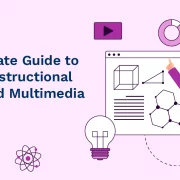
How Can Video-Based Training Technologies Be Used To Provide Interesting Training Videos?
Summary
Discover how video-based training technologies can create engaging and effective training videos, enhancing learner engagement and retention.
Training and updating your staff on new skills is crucial in today’s fast-paced business world. But how can you make this process more exciting and effective?
Enter video-based training technologies, the ultimate training tools for employees. We’ll explore the benefits of video-based training, how to create engaging training videos, and the best practices involved.
You’ll also learn how to measure the success of your training programs and take employee development to the next level.
Let’s dive in!
Table of Contents:
- The Importance of Training Tools For Employees
- Types of Video-Based Training Technologies
- Benefits of Video-Based Training Technologies
- Creating Interesting Training Videos using Video-Based Training Technologies
- Best Practices for Using Video-Based Training Technologies
- Wrapping Up
The Importance of Training Tools For Employees
The importance of employee training is critical to the success of any business. A company would want to invest in employee training for many reasons, but most importantly, it helps increase employee productivity and motivation.
Employee training should be ongoing throughout the year, not just once or twice yearly.
You might be wondering how video-based training technologies can engage employees. Here are some ideas:
- Use video as a coaching tool during live training sessions
- Use microlearning techniques
- Create interactive games or quizzes requiring learners to answer questions before progressing through the course material.
Types of Video-Based Training Technologies
There are different types of video-based training technologies. They include:
- Animated videos are animated images or graphics that can be used to explain concepts and processes. These can be created using different software programs such as Adobe Photoshop or SketchUp Pro.
- Live-action videos are recordings of real people taking tutorials in real time. They can also be captured with unique cameras that record at high speeds. When played back at an average rate, it looks like the person is moving slowly or standing still while speaking in slow motion or pausing between sentences/words/phrases to create emphasis in training materials.
- Interactive videos allow users to click on certain parts of the screen where they want more information about something specific before continuing their learning journey.
- Virtual reality (VR) videos give viewers an immersive experience by allowing them to see what it would be like if they were physically present in a specific place/environment–for example, employees in simulations of a scenario using tools at work and attending meetings/conferences without leaving the comfort of your homes.
Benefits of Video-Based Training Technologies
Video-based training technologies provide extensive toolkits for creating engaging training videos that can be used for various purposes, such as improving productivity, increasing retention rates, and creating marketing materials for promoting an organization’s products or services, among others.
Here are some of the benefits that video-based training solutions can offer:
1. Improved employee engagement
Video-based training solutions allow you to deliver content more engagingly than traditional learning methods like text or audio files. Employees will be more likely to retain information from their training sessions if they’ve been captivated by visually striking graphics/animations in the video or seen the event in real-time rather than read about it in an ebook or listen to audio recordings.
2. Cost-effective and efficient
They allow you to train employees on the job rather than sending them to a classroom or paying for outside trainers. This saves time and reduces costs associated with travel and other expenses related to learning new skills.
Video-based training technologies allow you to create engaging and interactive videos that can be viewed anytime, anywhere in the world. They allow employees to train themselves with little to no help from others, thus saving your company money on employee training costs.
3. Customizable and accessible
You can add text, images, and other visual elements to help explain complex concepts more clearly. Video-based training technologies enable users to access their content anywhere with an internet connection or mobile device such as a tablet or smartphone. You can easily access YouTube or similar platforms where videos can be downloaded onto devices.
You can also create courses that include multiple types of media such as text, audio, images, and video clips and other interactive features such as quizzes or polls that allow participants to take action right away after viewing a particular topic or concept covered in the course material.
Creating Interesting Training Videos using Video-Based Training Technologies
Video-based training technologies are a great way to provide interesting training videos. They allow you to convey complex information engagingly and memorably, but creating such videos is not always easy. Here are the steps on how to make your video training content more engaging:
1. Setting clear objectives and defining the target audience
This will help you determine what information needs to be conveyed and how best to do it. You need to find out what goals your audience wants to achieve and what challenges they face when trying to achieve these goals. By understanding these objectives, you can create a more engaging video training program that helps people reach their goals faster.
2. Scriptwriting and storyboarding
The purpose of this exercise is not just about conveying information — it should also engage learners so they not only broaden their skill sets by engaging in new learnings and reduce the gaps in understanding through learning and development initiatives. This means using persuasive language and phrases that capture attention and providing humor where appropriate (such as during transitions).
3. Incorporating engaging visuals and sound effects
Combining text with images makes the information easier to understand than if you were just reading what you need to know. You can also include sound effects in your video so that it feels more like a movie than just a series of slides or still images on your computer screen.
In addition, if you have access to royalty-free music, you can incorporate music into your video for added interest for learners.
4. Using gamification and interactivity to enhance the learning experience
Gamification and interactivity help build engagement with learners, which is essential for effective learning. You can incorporate elements like badges and leaderboards into your video-based training by adding interactive questions at various points in your content to entice participants to stay attentive.
You can also encourage participants to respond to what they’ve learned by sharing their thoughts and feedback on social media platforms such as Twitter or Facebook. Hence, the employees will stay motivated to improve, and the competitive edge will keep them engaged in the learning experience.
Best Practices for Using Video-Based Training Technologies
By using videos, you can provide information in a more entertaining and engaging manner. However, there are many different ways that video-based training technologies can be used to provide exciting training videos. Here are the best practices for using video-based training technologies:
1. Ensuring accessibility and compatibility
Since many employees will not have access to the latest high-end hardware or software, ensuring that your video training materials are compatible with older and newer systems is crucial.
This will allow more people to access them without worrying about compatibility issues. Also, following accessibility guidelines using closed captions, alt tags to your video, and more will help create an inclusive experience.
2. Measuring and analyzing the effectiveness of the training videos
You should analyze the effectiveness of your training videos by tracking how many people complete them and how long they take to achieve them. Track how often they are accessed over time and whether or not they improve performance on key metrics such as customer satisfaction or employee retention rates. This will allow you to determine what aspects of the videos need improvement to maximize their impact on your organization.
3. Continuously updating and improving the training materials
The more often you update your training materials, the more likely your employees will find them relevant and engaging. You should also ensure your videos include up-to-date information on new products, services, or processes related to the company.
Wrapping Up
You’ve read about the benefits and importance of video-based training technologies, but what are you waiting for? Maximize your ROI with Hurix’s cutting-edge technology and personalized learning solutions. Don’t wait – upgrade your training programs with our state-of-the-art online teaching platforms.
Also Read – 9 Ways to Create Highly Effective Learning Videos

A highly enthusiastic and motivated sales professional with over twenty five years of experience in solution selling of training-related applications and services. Maintains an assertive and dynamic style that generates results. Ability to establish long-term relationships with clients built on trust, quality of service and strategic vision. Specializes in financial services, higher ed, publishing and government in the areas of learning and development.





